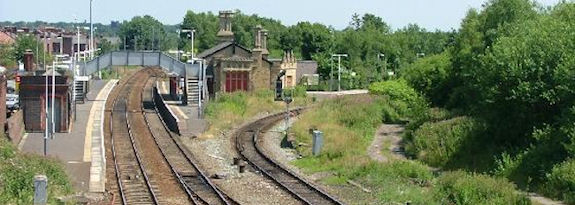
Built in the 1830s at the site of the first 'main line' junction and triangle. One of the oldest railway passenger buildings in the world.
Queens Street, Earlestown, Newton le Willows, WA12 9AU
Earlestown Station lies on the former Liverpool & Manchester Railway, opened on 15 September 1830. On 25 July 1831 the Warrington & Newton Railway was opened for public use, making a junction at a point in the township of Newton, facing in the direction of Liverpool.
The surviving Earlestown Station buildings were constructed around 1835 on the original site, at the point of intersection of these two early railways, incidentally forming the first steam railway junction, which was given the name Newton Junction. The locality was soon selected as the site of the company's carriage and wagon works, and thus developed into something of a 'company town', which was given the name "Earlestown" after James Hardman Earle, a director of the Liverpool & Manchester company. There was also a branch to a local colliery. The original building now forms the (currently unused) waiting room of Earlestown Station.
The Grand Junction Railway (GJR) absorbed the Warrington & Newton company 31 December 1834 and, from the GJR's completion of their trunk line from Birmingham on 4 July 1837, used it to access the Liverpool and Manchester line. A new curve was built at Newton Junction so that trains could run towards Manchester; this gave the station a triangular formation with six platforms.
The method of operation involved the despatch of a Grand Junction train from both Liverpool and Manchester to meet at Earlestown. These were joined together and continued as one train to Birmingham. Both portions conveyed through carriages (after 1839) to London. The Grand Junction trains arriving from Birmingham were usually split at Warrington (Bank Quay), and passed through Earlestown as separate Liverpool and Manchester trains.
The London and North Western Railway later operated their main line service to the Scottish border by way of Earlestown and Parkside, utilising a short section of the old Liverpool & Manchester line. This inconvenient routing was eliminated by the construction of the Golborne cut-off, a direct connection avoiding Earlestown.
Earlestown Station is regarded as having the oldest railway station building in the world that has survived on an operational passenger station. It is Listed Grade II. It is also connected to one of the world's first railway viaducts. The nearby Sankey Viaduct passes over the former Sankey Canal, built in 1757, and therefore the first canal of the industrial revolution.
The Red Wheel Transport Heritage Plaque was mounted in September 2022 and hopefully will be formally unveiled in Spring 2023
January 2023 update
Following a local campaign, a Government Levelling Up grant has been secured which will fund improvements at the station. The plans will see full lift access installed at the station, the triangle area cleared and transformed into a community parkland, potentially with allotments and open space, and the old station building brought back into use as a café and waiting room, as well as a heritage room similar to other stations.
St Helens Borough Council Newton-le-Willows East Councillor Seve Gomez-Aspron MBE, said: "This Levelling Up Fund money is one of a number of funding streams we are accessing to regenerate both town centres. For Earlestown, as one of only two stations in the UK built on a triangle, accessibility has always been an issue for both train users and people coming into Earlestown from Wargrave. This levelling up funding, along with the current Access for All bid, will transform the station with lift access in order to make it fully accessible."
National Transport Trust is pleased to have been part of this campaign and looks forward to these improvements being implemented.
Photos: El Pollock / Record-breaking waiting room, Earlestown railway station; Lmno at the English-language Wikipedia, CC BY-SA 3.0 <http://creativecommons.org/licenses/by-sa/3.0/>, via Wikimedia Commons; Googlemaps; Eric Shenton
By road: Off A572 on Queens Street, Earlestown.

Biddle, Gordon, Britain's Historic Railway Buildings, Oxford University Press, ISBN-10: 0198662475 (2003)
Biddle, Gordon & Nock, O.S., The Railway Heritage of Britain : 150 years of railway architecture and engineering, Studio Editions, ISBN-10: 1851705953 (1990)
Biddle, Gordon and Simmons, J., The Oxford Companion to British Railway History, Oxford University Press, ISBN 0 19 211697 5 (1997)
Bonavia, Michael, Historic Railway Sites in Britain, Hale, ISBN 0 709031564 (1987)
Conolly, W. Philip, British Railways Pre-Grouping Atlas And Gazetteer, Ian Allan, ISBN 0711003203 (1958/97)
Holt, Geoffrey, A Regional History of the Railways of Britain, North West, David & Charles, ISBN-10: 0715375210 (1978)
ISBN 0 7153 7521 0 (1978)
Marshal, C. F. Dendy, Centenary History of the Liverpool and Manchester Railway, Locomotive, ASIN B0010ZJ6IQ (1930)
Morgan, Bryan, Railways: Civil Engineering, Arrow, ISBN 0 09 908180 6 (1973)
Morgan, Bryan, Railway Relics, Ian Allan, ISBN 0 7110 0092 1 (1969)
Reed, M., The London & North Western Railway, Atlantic, ISBN 906899664 (1996)
Simmons, J., The Railways of Britain, Macmillan, ISBN 0333407660 (1961-86)
Simmons, J., The Victorian Railway, Thames & Hudson, ISBN 050025110X (1991)
Singleton, D., The Liverpool & Manchester Railway, Dalesman, ISBN-10 085206263X (1975)
Thomas, R.H.G., The Liverpool & Manchester Railway, Batsford, ISBN-10 0713405376 (1980)